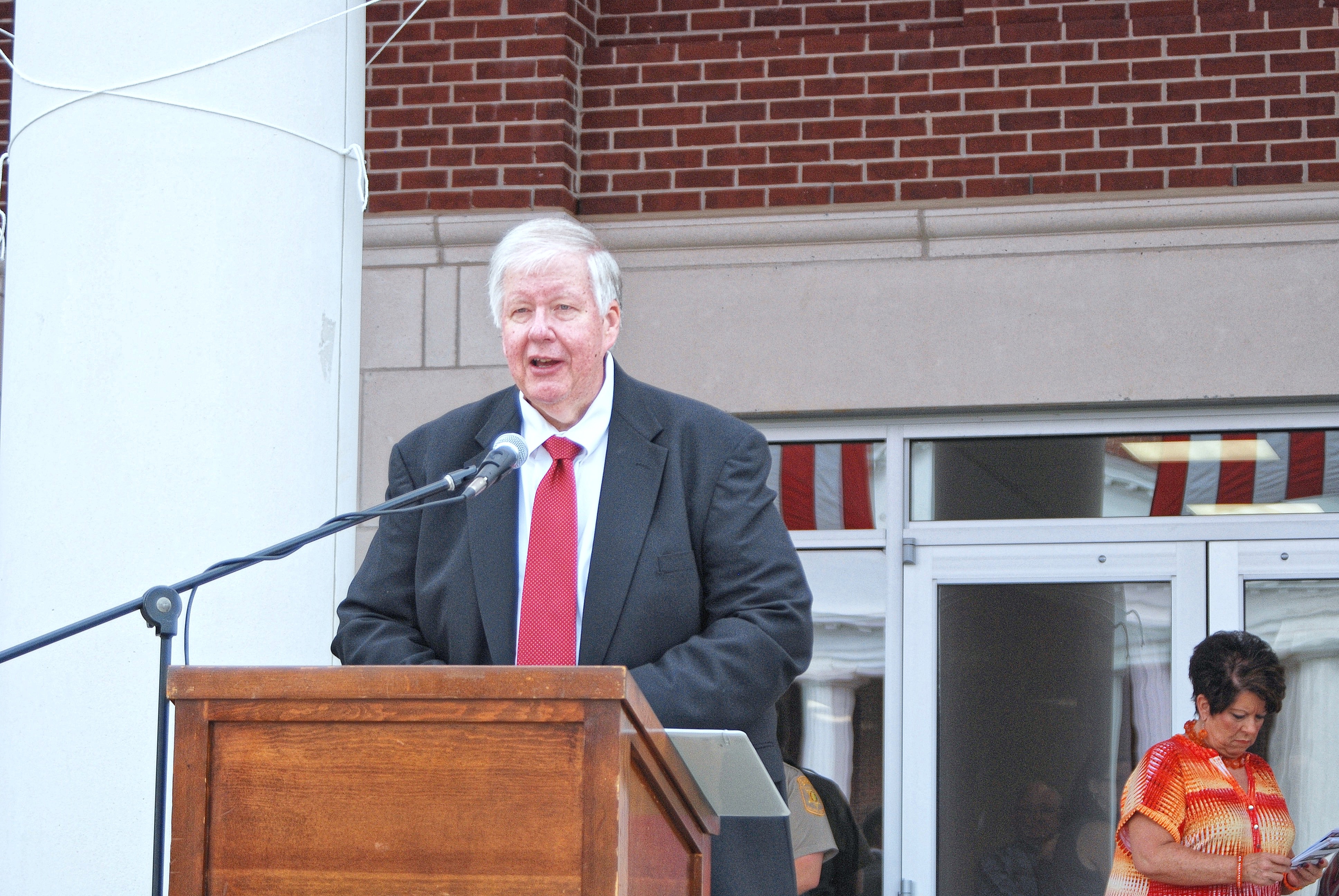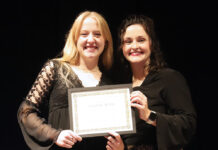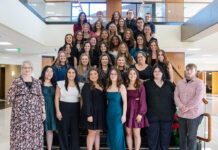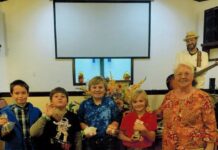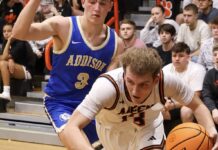Round 2's Greg Burks performs "God Bless America" as Col. Ken Brown looks on at the Cullman Elks Lodge during Wednesday night's Flag Day celebration. (Nick Griffin for The Tribune)
CULLMAN – Dozens made their way to the Elks Lodge Wednesday night for Cullman’s annual Flag Day celebration, which featured live music, refreshments and a colorful history of the U.S flag.
Cullman Elks Lodge member Dale Ball said, “This ritual is a long-standing and important part of the National Elks tradition this week. All across the nation Elks are proudly leading their various community observances of Flag Day. We’re very proud to welcome the combat veterans of VFW Post 2214 and I am pleased that they are joining us in the presentation of the colors tonight.”
Ball continued, “I also want to welcome the members of the Cullman chapter of the Sons of the American Revolution (SAR) and thank them as well for participating with us in our ceremony. I would like to extend a warm welcome to the elks who are visiting from Marshall County Lodge number 2869, we welcome these guys, and finally I would like to introduce Mr. Greg Burks who will be offering us some patriotic music this evening. Some of you may know Greg as the lead guitarist and vocalist for the very popular local Round 2 band.”
After the “Star Spangled Banner” and an invocation, Col. Ken Brown took to the podium to talk about the history of the flag and the changes it has gone through during the nation’s history. Brown explained each design, as veterans spanning multiple eras carried in each flag and placed it at the front of the room.
SAR member Smokey Ferguson carried the Pine Tree Flag to start the program, followed by the Snake Flag bearing the famous phrase “Don’t Tread on Me” carried by SAR member Larry Howell.
The third flag presented was the Continental Colors Flag, carried by World War II veterans Thurman Ryan and Julian Campbell.
Vietnam veteran and two-time Purple Heart recipient Robert Turner brought up the next flag, the first 13-Star flag created by Betsy Ross in 1776 and was followed by Vietnam veteran and two-time Purple Heart recipient Bill Corwash, carrying the 15-star flag representing the admissions of Vermont and Kentucky in 1795.
The sixth flag of the evening was that from the year 1818 consisting of 20 stars and was brought in by retired U.S. Army Major and Purple Heart recipient Robert Stephens; the seventh flag, bearing 48 stars, was carried by Vietnam veteran and former Green Beret Will Harris.
The final flag presented as part of the program, the current 50-star flag, was carried to the front of the room by Desert Storm and U.S. Airforce veteran Darell Brewer.
Former Deputy Director of the U.S. Space and Rocket Center and former Cobra Attack Helicopter pilot in Vietnam, Col. Ralph Bryson, was the night’s guest speaker.
“It’s special that we share this story because it’s about a U.S. Navy Lt. Commander named Mike Christian,” said Bryson. “Lt. Commander Christian was actually from Alabama and grew up outside of Selma. Following growing up in Selma, Mike and his family moved to Huntsville and he graduated from Butler High School. He went to the University of Alabama and joined the Navy in 1958. He enlisted after spending one semester at Alabama and not long after that he joined a program and went to Purdue University where he graduated five years later with a degree in electrical engineering.”
Bryson spoke of Christian’s time in Vietnam, noting the latter’s time as a prisoner of war (POW).
“He went on to flight school from there and was a navigator bombardier and went to Vietnam and served. He was shot down in April of 1967 and was a POW for six years until April of ’73. The stories kind of diverge on whether it was an old handkerchief or just a piece of cloth that he was able to find, but from that he began to make an American flag. The story I tend to believe is that he sewed it on the inside of his shirt; basically, all he had was his shirt and sandals. I believe that the average story was he took his bamboo needle that he made himself, took pieces of tile and brick dye that his fellow prisoners got for him, and he sewed the American flag on the inside of a very small piece of cloth inside his shirt. After he got it done he was trying to show it off and showed it to the fellow prisoners and it became a daily routine,” Bryson said.
“When they saw that at a certain time each day, they all got together and pledged allegiance to the flag. Think about that, you’re 10,000 miles away from home, you don’t have a flag, you’re in a very small cell with one lightbulb by most accounts, you get outside once a day for a few minutes to maybe take a shower or get a little food and during that time when they were outside, the guards went in and searched the cells. They found his shirt and the flag and that didn’t go over well, as you can imagine. That night they drug him out of the cell and he was severely beaten.”
Bryson wrapped up his time by leaving the audience with a reminder of why the flag is celebrated.
“By most accounts he was one of the most tortured and punished POWs that served. When they brought him back in severely beaten, his fellow prisoners nurtured him back to health as best they could, but of course his flag was gone. That didn’t deter him; pretty quickly he went back, got him another needle and crafted another American flag and did exactly the same thing,” Bryson said. “When we think about the national anthem and we think about the Pledge of Allegiance, it’s only fitting that during that time we think about the sacrifices that many went through and what that flag meant to them, tens of thousands of miles away huddled up into a small group and saying the Pledge of Allegiance or perhaps humming the national anthem.”
Copyright 2018 Humble Roots, LLC. All Rights Reserved.

